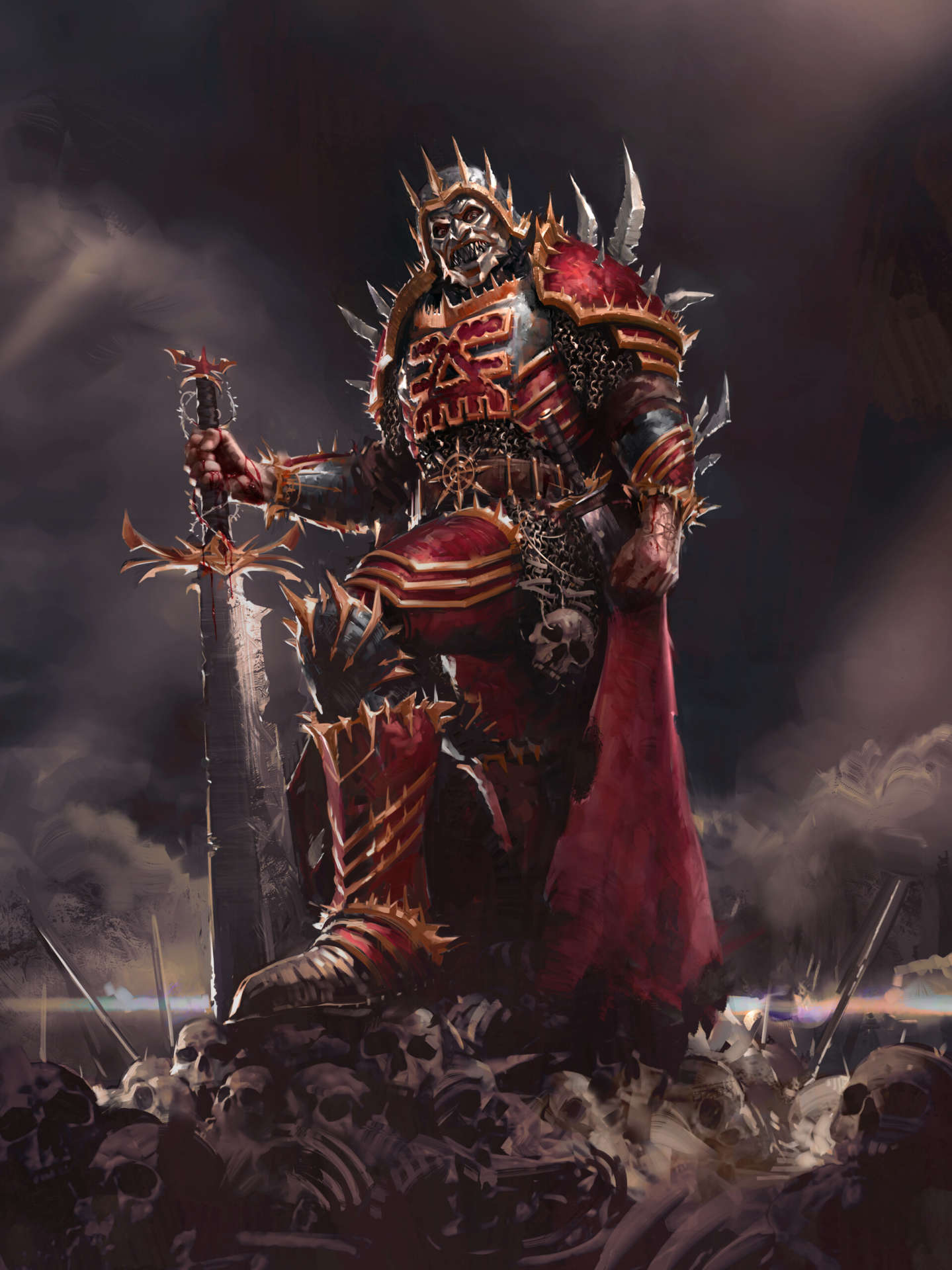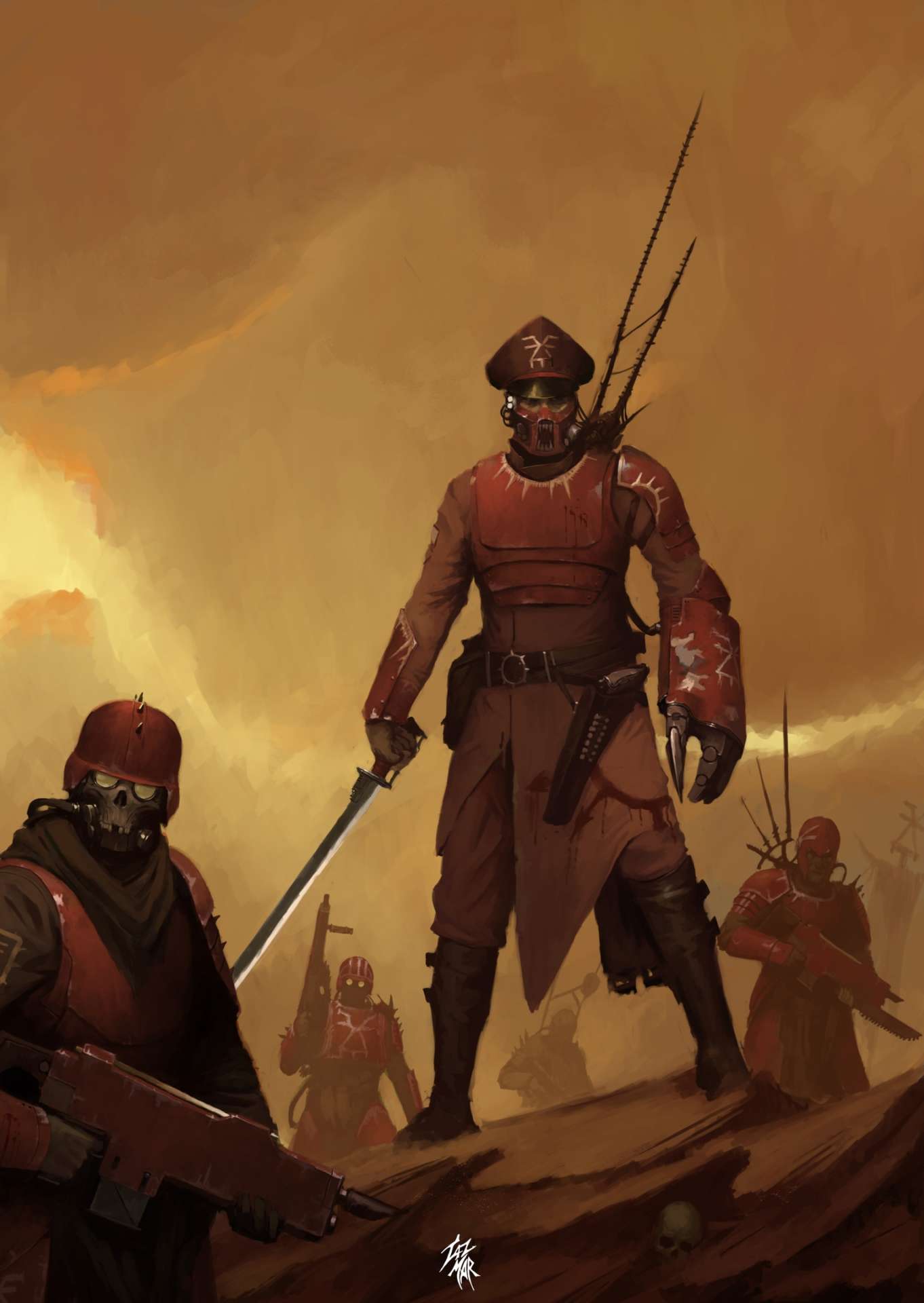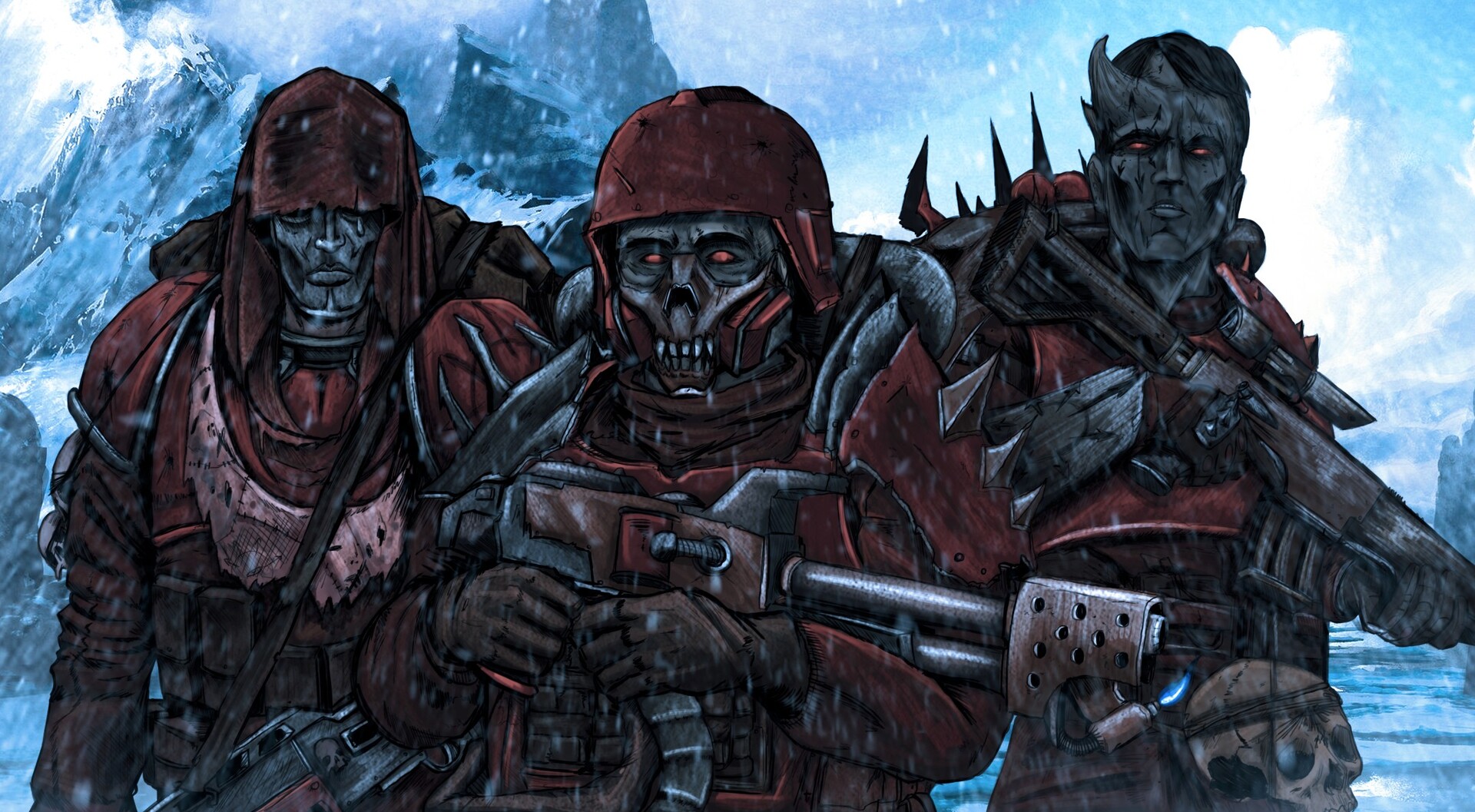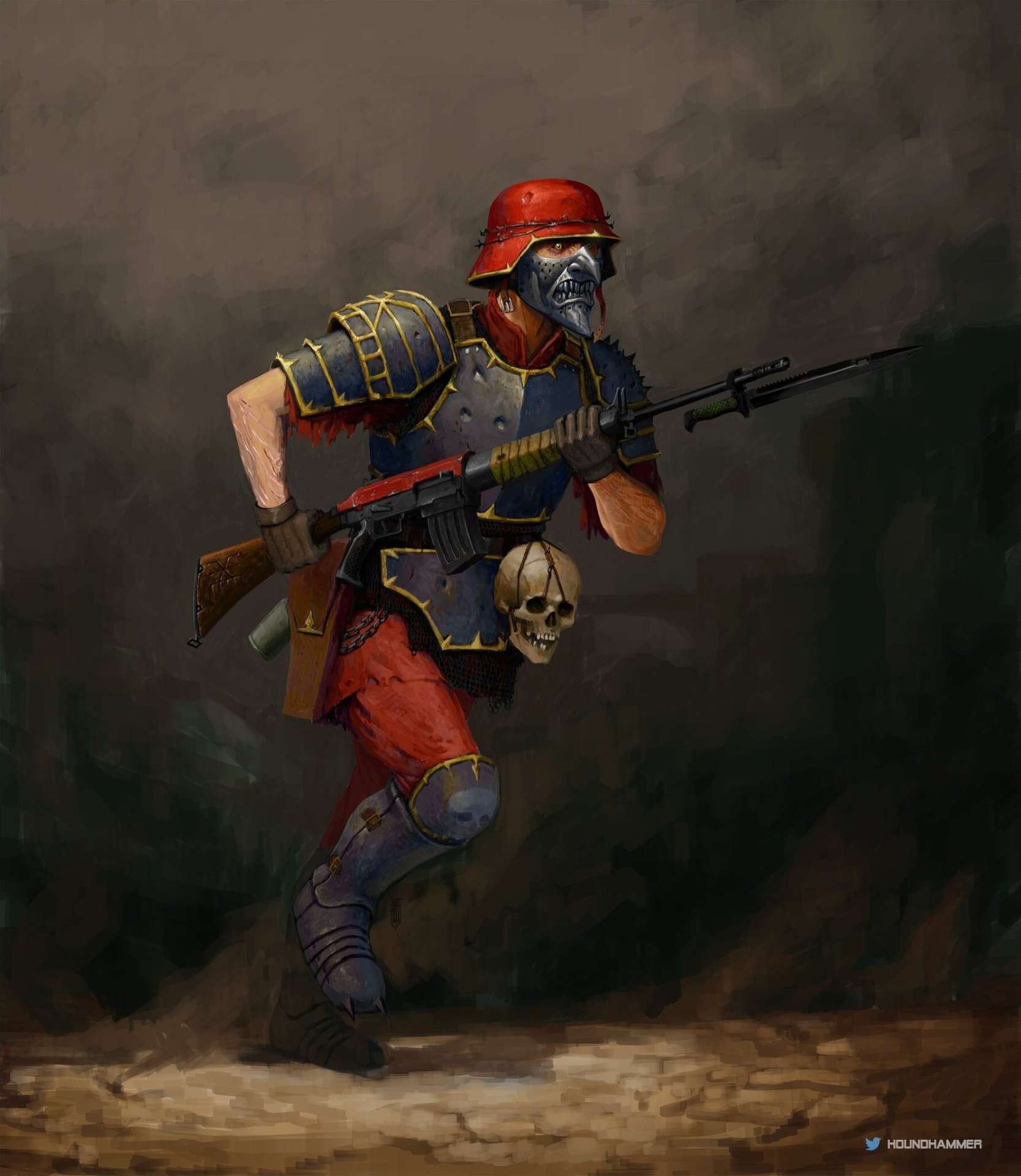Canon Lore
Header: cover art for Dan Abnett's, Sabbat Crusade,
by artist Raymond Swanland. Source.
The Sherden Pact, the Sanguinary Utnapishtim, basically everything I am up to here, is one big fanfic spin off from Dan Abnett's Gaunt's Ghosts series (example linked above). In particular, one of the primary antagonist factions therein, known as the Blood Pact. They caught my attention, and certainly not me alone my impression is they are very popular in the fandom - GW give us more like this! (They even have their own fanmade metal song! This is also a wonderfully grisly little horror tale of life as a kind of camp-follower of a similarly themed force.) I think what I and others are picking up on is that they are fascinating as a depiction of an organised and competent chaos force, who actually run large scale societies for a great length of time and successfully... by their own terrible lights. So I will explain the basics of that setting here, providing links to fan-wiki's and what not where appropriate, while also showing off art works people have done of them along the way.
The Gaunt's Ghosts books tell the story of the Sabbat Worlds Crusade. In particular, they tell the story of a particular (at the start of the series) pious, talented, and ambitious young officer; Commissar Ibram Gaunt. He is given command of a new recruits from the world of Tanith, but just as the regiment is departing the enemy turn up and Alderon their planet. His regiment are thus the last survivors of their homeworld, the Ghosts of Tanith. Hence the series name, Gaunt's Ghosts.
We follow the Ghosts' adventures across this long war, as the Imperium seeks to retake the Sabbat Worlds. This is a very large cluster of planets that were first conquered by the Imperium of Mankind centuries ago, when they were led by a figure they now revere as a saint - St. Sabatine. The old enemy in this region is a cluster of dispirate and not-all-that-united tribal societies known as "the Consanguinity". What they have in common, however, is that they worship the blood god, Khorne.
Now all in all Khorne is not too complex a fellow, he is the god of rage, fury, warrior stuff, martial honour, etc. His worshipers have the slogan "blood for the blood god, skulls for the skull throne", which sort of summarises their whole schtick. Relevant to the Sabbat World Crusade is that Khorne is a sworn enemy of the Imperium of Mankind. So naturally enough his worshipers very much do not like their worlds being occupied by the Imperium, who suppress any rival religion in territory they conquer. And, well, in any case; they were there first. So the Consanguinity united against the Imperium, retook a bunch of their own worlds, and the Imperium launched the crusade our heroes find themselves upon to try and swing things back in their favour.

Lovely chap, great with kids.
The Blood Pact are a force within the Consanguinity, an especially elite and well organised force sworn to the service of the Archon, Urlock Gaur. In fact, Gaur has (at the time the series starts) recently become the overall cultural and military leader of the Consanguinity. Since he's a much more competent leader than the bloke he was replacing, and his personal forces are large, well organised, and fanatically loyal, this is something of a problem for our plucky heroes. As the books go on, we see them go up against both the Blood Pact and their various allied forces of the Consanguinity.
What makes the Blood Pact stand out is, as I said, the fact that they are well organised. They act more like a disciplined military force than a bunch of wild berserkers. We even get a book which is for a significant portion from their point of view. Here we see them interact as squad mates (and in fact as family members in two cases), make plans and adapt to a changing situation, have religious ideals, be willing to fight and die for a cause they believe in. It sounds like basic stuff, but actually in 40k worshipers of Khorne are so often overcome with fury and a sort of magical empowering rage that this degree of sophistication and comprehensible motivation is unusual. If you are interested in world building it makes them a challenge -- what makes this possible for them, such that it isn't for others?
I won't spoil the series. It's a lot of fun, worth reading if you like war epics. It's Sharpe... in space! I will just say here that we do get at least some hints of how this is all meant to hang together within the material I have read. So we see that unlike most Khorne worshipers they do have ways of interacting with the "warp" in disciplined goal directed ways -- typically the Blood God disdains magic (called "psychers" in 40k lingo) as weak, but the Blood Pact have a role known as "Goremages" which basically amounts to having Khorne approved wizards. So somehow they have found ways of sufficiently mastering the chaotic realm for it to be usable by them, consistent with their religion. We also learn that they do actually consider the Emperor an important religious figure, they just disagree about precisely how he relates to the other Divine creatures of their pantheon. (This makes them one of the few examples of actual heretics in 40k relative to the Imperium's state religion, which considering how often the word is thrown around in the lore is quite an achievement.) Between such things you get the impression of an actual theology, actual religious traditions.

Posted with artist's permission.
We also know that they have an organised military structure, wtih ranks whose name we learn! At the top is the Archon, beneath which are Etogaur, beneath which Demigaur, beneath which Damogaur, beneath which Sirdar, beneath which Katogaur, beneath which the lowest ranking warriors of the Pact. They have distinctive linguistic quirks, e.g. rank follows name - so rather than saying "Sgt. Apone" they would say "Apone Katogaur", for instance. We learn that they have norms they actually abide by - e.g. they prohibit killing each other unless one is a special disciplinary officer (known as "Arnogaur"). We also see a society they (technically an allied group consciously modelling themsleves on the Blood Pact) run. It's horrible, an authoritarian military dictatorship on a constant total war footing. But it is also, well, a society; it has police, agricultural methods, labour management policies, and so on. These things suggest organisation, institutional structure, law of a sort.
All this is stuff which, if you are a nerd for world building, makes them extremely interesting! They are set up to be an exception to a general rule. Generally we know that people who worship the Blood God tend to become consumed with rage and burn out in relatively short order. Here for a good time not for a long time, that sorta deal. But we know they are unlike that, and we get just enough little hints at the sort of differences that might explain this different outcome that a certain sort of nerd brain can't resist trying to find out more. It is me, that nerd brain is mine. These are the elements I wanted to pick up upon and run with in homebrewing my own little warband.
Honestly the vast majority of the specific 40k lore I will be relying on is covered by this. But then thare general background facts about the setting you might want to follow up on. If that is to your interests then there are lots of fun YouTube chanels that cover basics of how the lore works in a short accessible fashion. I like all these three, and those videos cover stuff I defintely had in my mind when writing. Enjoy!
Just before logging off I rememebred another thing I will be appealing to! The setting I make use of is within `Imperium Nihilus', in fact I guess I can place it in `Segmentum Obscurus'. Roughly speaking: the galaxy of the 40k verse is split in two, and half of it (Nihilus) is in incredibly dire straits even relative to the grimdark future. In this half of the galaxy the chaos forces can still carry out inter-stellar travel and communication with relative ease, whereas almost all the other factions have much more difficulty in so doing. Given that this is a setting focused around inter-stellar warfare, that's a very significant advantage for team chaos! So, if you want to make a setting focused on a plucky upstart chaotic empire it seems a good place to be!
That's pretty much all you need to know about that. Now, the timeline for Blood Pact warriors being there in the official lore doesn't really work out. But, never fear: I handwaved it. Phew!

